The Technologically Advanced Mamiya "X" Series
The Mamiya Auto XTL and Mamiya X-1000 were cameras that did not sell as well as Mamiya hoped despite - or perhaps because - they were introduced years ahead of their time. Still, this family of two were truly unique cameras. The Auto XTL shutter-priority automatic exposure SLR was on the market before the AE SLR's of Nikon, Minolta, Pentax or Canon (although this may not be universally true, since I do not believe the Auto XTL was marketed at all in the UK). Its CDS meter even measured light at the ideal point, at the film plane. At its introduction the Auto XTL was, according to Stephen Gandy, author of the well-respected CameraQuest web site, "arguably the most technologically advanced 35mm SLR in the world."
The Mamiya/Sekor Auto XTL, introduced in April 1971, was probably the most advanced SLR camera of its day.
Visible in the XTL viewfinder, this sturdy, metal-bodied camera showed the six percent spot-metering pattern, and indicators for which meter pattern (Spot or Averaging) the camera was measuring. It also had electronic indicators for both shutter speed and F-stop (see finder image below).
Unfortunately, the Auto XTL was designed well before LCD's and LED's existed, so the viewfinder readout depended entirely upon illumination from the subject which, as you can imagine, made it very difficult to see in dim light situations. An otherwise purely mechanical camera, this dual meter function was powered by one (1) MS-76 or equivalent battery (1.5v), which is still plentiful today.

With the most advanced viewfinder of its era, the XTL
unfortunately depended on outside illumination, since the
LED technology for self-illumination did not yet exist!
With a very fast 55mm f/1.4 as its standard lens, the XTL was the first shutter priority auto-exposure 35mm SLR with both spot and averaging TTL metering (continuing what Mamiya began with its earlier DTL-series).
Even more amazing, the Mamiya XTL placed a hinged, printed circuit board just behind the pellicle mirror and directly in front of the film plane to meter the light. As "Modern Photography Magazine" pointed out in their May 1971 lab test and review of the XTL, this is theoretically the ideal place to take an exposure reading.
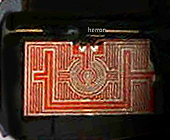
The Mamiya Auto XTL meter circuit board (above).
Unfortunately for Mamiya (again), the Auto XTL was almost too advanced, and wide skepticism about its innovative new features made professional camera buyers cautious about it.
Mamiya marketers who positioned the Auto XTL in a "professional bracket" apparently did not fully recognize the very conservative nature of the professional photographers of the time, who did not take very well to their craft being overtaken by such automation. Thus, they did not get the "halo" of professionalism they had hoped for by positioning the Auto XTL in such an upscale price bracket, and it did little to foster wide acceptance in the advanced amateur market.
Although Mamiya's excellent engineering innovation was once again abundantly evident, the Auto XTL had to compete with the more established camera systems like the Nikon Ftn, the Topcon Super D, the Canon FTb QL and the Minolta SRT 101...a tough marketing challenge for any camera.
Not surprisingly, poor sales from an overly cautious response by their targeted buyers led Mamiya to almost immediately limit production dramatically (although no records of the exact figures are known to exist).
A motor drive and bulk back were both also planned for the XTL. Although some units were reportedly made, neither accessory ever progressed beyond a limited early-production phase. Undoubtedly because of the XTL's poor initial sales showing, they were never put into full production, and both accessories are extremely rare on the used market today.
Mamiya/Sekor ES Lenses
The "ES" lenses for the Mamiya Auto XTL departed from the 42mm "universal Pentax-Praktica" thread-mount used on its TL-DTL series (used again on the SX-series to come), opting instead for a unique bayonet-mount. The sharp, contrasty ES lenses also came in a surprising variety, from a 21mm f/4.0, to an extremely long 800mm f/8.0 (the 800mm broke into sections for easier carrying, much like the longer Leica lenses). It seems obvious Mamiya fully intended to initiate a complete "top end" camera system.
Longer focal length ES lenses are extremely difficult to find today. Production for the XTL and X-1000 series combined was limited to barely five years, and it is hard to imagine long manufacturing runs for extreme lenses in that time. Virtually none of the independent lens brands offered an XTL mount, so less-expensive lens options were almost non-existent.
Camera expert Stephen Gandy verifies that Spiratone seems to be the only aftermarket supplier of lenses for the XTL. It is possible the Spiratone name could also have been affixed to lenses actually manufactured by other independent makers, and Spiratone lenses for the XTL may also have been sold in Japan under entirely different brand names, but I have no evidence to support that conclusion.

MAMIYA AUTO XTL (c.1971)
CLICK HERE for Auto XTL lens and accessory information.

ABOVE: The MAMIYA/SEKOR AUTO XTL "ES" lenses had a unique tapered barrel, designed as an ergonomic improvement for handling and focusing.
An all black-bodied version of the XTL was available, according to a Paul Farber article in the May 1971 "Camera 35" magazine. It must have seen extremely limited production. In more than 30 years, I have only seen a few examples.
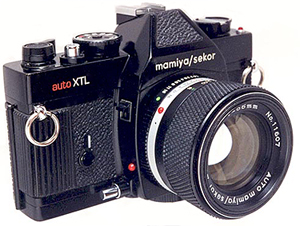
Hinted at by a 1971 Paul Farber review, and mentioned by Stephen Gandy, an all-black version of the Auto XTL existed, as evidenced by the photo of mine above. No production data has been found for how many were produced, but it is extremely rare today.
XTL Prototype?
Was there a one-of-a-kind, Mamiya XTL prototype made that looked like the XTL model that was eventually distributed, but was called a Mamiya auto DTL 1000? Gentle Reader, Per Malare, in Sweden, has provided pictures (below) that show such a prototype camera existed...and I have actually held this camera in my hands, so I know it's real!
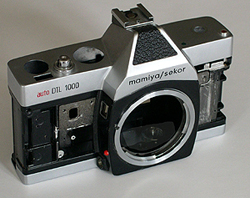

ABOVE: These pictures demonstrate a camera with all the styling cues of the AUTO XTL, from the vinyl-clad prism housing and other similarities on the top plate; to the bottom plate, with its four mounting screws and the access cap for the XTL auto winder.
In the pictures above, it is clearly identified as an AUTO DTL 1000. What may not be obvious in these photographs, but should be pointed out, is that the interior of this particular camera was obviously not meant to be a working item. Was this instead a prototype of an XTL to come?
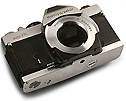
Mamiya/Sekor Auto XTL P-Adapter
The XTL "P-mount adapter" was available in two different versions (shown below), both allowing the use of 42mm threaded lenses, obviously marketed as a way to let users keep the TL- and DTL-series lenses they may have had. The adapter also allowed the use of similarly threaded lenses from many other lens manufacturers, thus making the XTL attractive to users of other cameras. Along with the XTL camera body itself, these adapters (either version) are a rare, sought-after item in the Mamiya-collectable arena today.
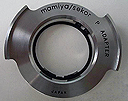
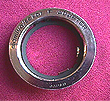
ABOVE: The XTL P-mount adapter in both known versions.
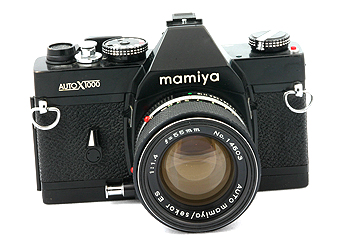
MAMIYA AUTO X-1000 (c.1975)
X-1000 lens and accessory information below.
Mamiya Auto X-1000
The Mamiya Auto X-1000 (the Sekor name was dropped), was introduced in 1975, intended as the successor to the Mamiya/Sekor Auto XTL.
Similar in most functions to the XTL, the Auto X-1000
also provided exposure warnings in the finder. Where the XTL was black-and-chrome,
the X-1000 featured an all-black finish (and had no leather insert on the
prism cover). It also had no motor-drive connection. Like the XTL, it uses
one (1) MS-76 or equivalent battery. It was also designed to use Mamiya
ES series bayonet-mount lenses. The internal workings of those lenses was
the same, but the lens barrels were covered with a checkerboard-pattern
sleeve instead of the fluted and tapered barrel of the Auto XTL.
A remarkably-made piece of equipment, with sharp, contrasty lenses, the
Mamiya Auto X-1000 is a rare find today, and extremely rare to find in good
condition, since production was limited to just one year.